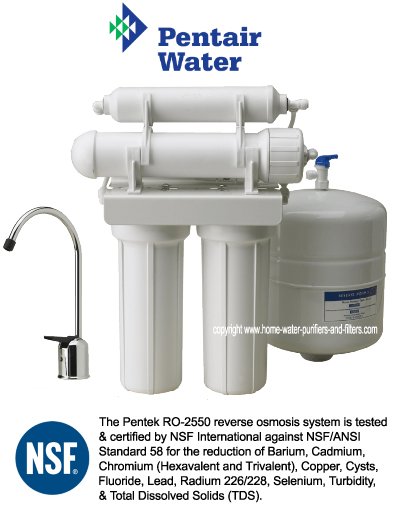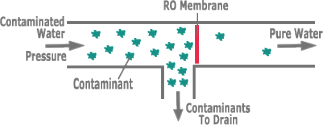Reverse Osmosis (RO) Water Filters

Pentek RO-2550 Reverse Osmosis System | List Price: US$ Our Price: US$209.00 You save: $171.00 Write a review. Found a Lower Price? Request a Price Beat |

 Lowest Price Guaranteed!If you find a lower price on this product call us or Click here to request a price beat. |
Reverse osmosis, also known as hyperfiltration, is the finest filtration available today. It is the most common treatment technology used by premium bottled water companies. It is effective in eliminating or substantially reducing a very wide array of contaminants, and of all technologies used to treat drinking water in residential applications, it has the greatest range of contaminant removal. Reverse osmosis will allow the removal of particles as small as individual ions. The pores in a reverse osmosis membrane are only approximately 0.0005 micron in size (bacteria are 0.2 to 1 micron & viruses are 0.02 to 0.4 microns).
There are two types of reverse osmosis membranes commonly used in home water purification products: Thin Film Composite (TFC) and Cellulose Triacetate (CTA). TFC membranes have considerably higher rejection rates (they will filter out more contaminants) than a CTA membrane, however, they are more susceptible to degradation by chlorine. This is one of the reasons why it is important that a reverse osmosis system include quality activated carbon pre-filters.
A typical RO system is composed of an array of granular activated carbon (GAC) pre-filters, the reverse osmosis membrane, a storage tank, and a faucet to deliver the purified water to your countertop. Reverse osmosis systems vary in membrane quality, output capacity, and storage capacity.
Reverse osmosis uses a semi-permeable membrane, allowing pure water to pass through it, while rejecting the contaminants that are too large to pass through the tiny pores in the membrane. Quality reverse osmosis systems use a process known as crossflow to allow the membrane to continually clean itself. As some of the fluid passes through the membrane the rest continues downstream, sweeping the rejected contaminants away from the membrane and down the drain. The process of reverse osmosis requires a driving force to push the fluid through the membrane (the pressure provided by a standard residential water system is sufficient - 40 psi+).  |
Reverse osmosis is an excellent choice for almost all home water purification needs. It is the most recommended solution for individuals on a pre-treated municipal water system. While reverse osmosis can be very effective in removing bacteria and viruses, it is not recommended that reverse osmosis be the only level of purification for water that contains or may contain biological contaminants (untreated well or lake water, for instance). For these applications consider a combined reverse osmosis / ultraviolet system or the addition of a complementary whole-house ultraviolet system for maximum effectiveness and protection against bacteria and viruses. Since membranes are subject to degrading by chlorine, iron, manganese, and hydrogen sulfide, and to bacterial attack, a sediment pre-filter and an activated carbon pre-filter and/or post-filter should be included with your reverse osmosis system. Water softeners can be used in advance of the RO system when household water is excessively hard to prevent pre-filter and membrane fouling. RO systems are generally the best choice for water contaminated with high nitrite levels as might be found in agricultural areas. |
| What Contaminants Does Reverse Osmosis Remove? |
|---|
Reverse osmosis (RO) units remove substantial amounts of most inorganic chemicals (such as salts, metals, minerals) most microorganisms including cryptosporidium and giardia, and most (but not all) inorganic contaminants.
Reverse osmosis successfully treats water with dissolved minerals and metals such as aluminum, arsenic, barium, cadmium, chloride, chromium, copper, fluoride, magnesium, iron, lead, manganese, mercury, nitrate, selenium, silver, sulfate, and zinc. RO is also effective with asbestos, many taste, color and odor-producing chemicals, particulates, total dissolved solids, turbidity, and radium. When using appropriate activated carbon pre-filtering (commonly included with most RO systems), additional treatment can also be provided for "volatile" contaminants (VOCs) such as benzene, MTBE, trichloroethylene, trihalomethanes, and radon. Essentially, reverse osmosis is capable of rejecting bacteria, salts, sugars, proteins, particles, dyes, heavy metals, chlorine and related by-products, and other contaminants that have a molecular weight of greater than 150-250 daltons. The separation of ions with reverse osmosis is aided by charged particles. This means that dissolved ions that carry a charge, such as salts, are more likely to be rejected by the membrane than those that are not charged, such as organics. The larger the charge and the larger the particle, the more likely it will be rejected.
| Arsenic | Bacteria and Viruses |
Bad Tastes & Odors |
Chlorine | Fluoride | Hydrogen Sulfide |
Heavy Metals |
Nitrates | Radon | Sediment | Iron | VOC's |
 |
 * * |
 |
 |
 |
 |
 |
 |
 |
 |
 |
 |
 = Effectively Removes
= Effectively Removes  = Significantly Reduces
= Significantly Reduces  = Minimal or No Removal
= Minimal or No Removal
* Even though reverse osmosis is effective in removing bacteria and viruses, it is not recommended that you rely solely upon reverse osmosis if your water is contaminated with bacteria or viruses. Ultraviolet (UV) purification is also recommended.
please CLICK HERE.
|
|
Pentek RO-2550 (NSF-Validated) |
To reduce membrane fouling and to maintain optimal performance, it is important to ensure that scheduled replacements of carbon or other pre-filters are followed. The reverse osmosis membrane (thin film composite - TFC) should be replaced every 2-3 years. |
| Frequently Asked Questions About Reverse Osmosis |
|---|




